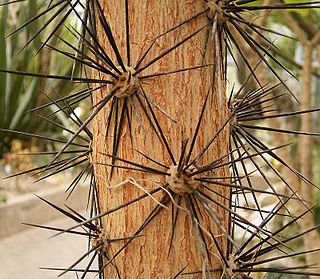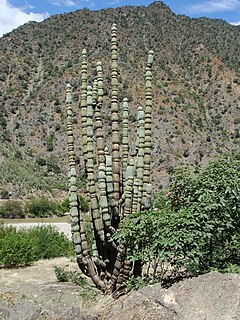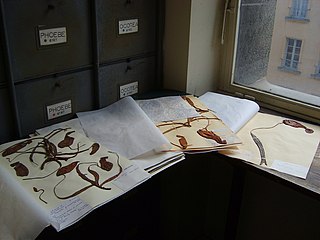
A cactus is a member of the plant family Cactaceae, a family comprising about 127 genera with some 1750 known species of the order Caryophyllales. The word "cactus" derives, through Latin, from the Ancient Greek κάκτος, kaktos, a name originally used by Theophrastus for a spiny plant whose identity is not certain. Cacti occur in a wide range of shapes and sizes. Most cacti live in habitats subject to at least some drought. Many live in extremely dry environments, even being found in the Atacama Desert, one of the driest places on earth. Cacti show many adaptations to conserve water. Almost all cacti are succulents, meaning they have thickened, fleshy parts adapted to store water. Unlike many other succulents, the stem is the only part of most cacti where this vital process takes place. Most species of cacti have lost true leaves, retaining only spines, which are highly modified leaves. As well as defending against herbivores, spines help prevent water loss by reducing air flow close to the cactus and providing some shade. In the absence of leaves, enlarged stems carry out photosynthesis. Cacti are native to the Americas, ranging from Patagonia in the south to parts of western Canada in the north—except for Rhipsalis baccifera, which also grows in Africa and Sri Lanka.

In botany, areoles are small light- to dark-colored bumps on cacti out of which grow clusters of spines. Areoles are important diagnostic features of cacti, and identify them as a family distinct from other succulent plants.The spines are not easily detachable, but on certain cacti, members of the subfamily Opuntioideae, smaller, detachable bristles, glochids, also grow out of the areoles and afford additional protection.
Curt Backeberg was a German horticulturist especially known for the collection and classification of cacti.

Armatocereus is a genus of mostly tree-like cacti from South America. These species have a conspicuous constriction at the end of the annual growth. The flowers are mostly white, with a more or less spiny ovary. The fruits are mostly spiny.

Frailea is a genus of globular to short cylindrical cacti native to Brazil. These species are cleistogamous. They were first classified in the genus Echinocactus.

Echinocactus grusonii, popularly known as the golden barrel cactus, golden ball or mother-in-law's cushion, is a well known species of cactus, and is endemic to east-central Mexico.

Echinocereus reichenbachii is a perennial plant and shrub in the cactus family. The species is native to the Chihuahuan Desert and parts of northern Mexico and the southern United States, where they grow at elevations up to 1,500 meters (4,900 ft). This cactus earned the Royal Horticultural Society's Award of Garden Merit.
David Richard Hunt is an English botanist and taxonomist. He is a specialist in cacti and the spiderwort family notably compiled the 1999 CITES Cactaceae Checklist.

Michael Joseph François Scheidweiler, was a German-born professor of botany and taxonomist, whose main area of interest was the Cactaceae. From a collection by Henri Guillaume Galeotti, he first described Ariocarpus retusus, type species of the genus in 1838 in Brussels.
Henri Guillaume Galeotti was a French-Belgian botanist and geologist of Italian parentage born in Paris. He specialized in the study of the family Cactaceae.
Christoph Friedrich Otto was a German gardener and botanist.

Parodia leninghausii is a species of South American cactus commonly found as a houseplant. Common names include Lemon Ball cactus, Golden Ball cactus and Yellow Tower cactus.

Gymnocalycium mihanovichii is a species of cactus from South America. The most popular cultivars are varied mutants which completely lack chlorophyll, exposing the red, orange, or yellow pigmentation. These mutant strains are often grafted onto the hylocereus cactus, and the combined plant is called a "Moon Cactus". Moon cacti are commonly grown as houseplants and are also known as Ruby Ball, Red Cap, Red Hibotan, or Hibotan cacti.
Frédéric Albert Constantin Weber was a French botanist, who specialized in Cactaceae.
Karl Theodor Rümpler was a German botanist and horticulturist.

Heinrich Poselger was a German botanist who specialized in studies of succulent plants.

Friedrich Bödeker was a German botanist who specialized in cacti studies.

Gymnocalycium baldianum, the spider-cactus or dwarf chin cactus, is a species of flowering plant in the cactus family Cactaceae, native to the Catamarca Province in Argentina.














